Development and validation of a nomogram for sleep disorders among stroke patients
IF 1.8
4区 医学
Q3 CLINICAL NEUROLOGY
引用次数: 0
Abstract
Background
Precisely identifying high-risk sleep disorder patients and implementing suitable measures are important for decreasing the incidence of sleep disorders. In this study, a nomogram method was adopted to construct a tool to predict sleep disorders in stroke based on four factors: individual characteristics, treatment-related factors, psychological factors, and family-related factors.
Methods
A total of 450 stroke patients were continuously diagnosed at the Affiliated Hospital of Nantong University, and the data on participants were randomly distributed into a training set (n = 315) and a validation set (n = 135). Within the training set, using LASSO regression and random forest methods, five optimal predictors of sleep disorders were identified. Five optimal predictors were used to develop a model. The calibration, discrimination, generalization, and clinical applicability of the model were evaluated using calibration curves, receiver operating characteristic (ROC) curves, internal validation, and decision curve analysis (DCA).
Results
We found that the place of residence, average daily infusion time, the Hospital Anxiety and Depression Scale (HADS), the Type D Personality Scale-14 (DS14), and the Fatigue Severity Scale (FSS) were crucial factors associated with sleep disorders. The validation data showed an area under the curve (AUC) of 0.903 compared to 0.899 in the training set. There was an approach to the diagonal in the calibration curve of this model, and the results of DCA noted that it is clinically beneficial across a range of thresholds from 5 % to 99 %.
Conclusion
A model was developed to predict sleep disorders among stroke patients to help hospital staff evaluate the risk among patients and screen high-risk patients.
中风患者睡眠障碍提名图的开发与验证。
背景:准确识别高危睡眠障碍患者并采取适当措施对于降低睡眠障碍的发病率非常重要。本研究采用提名图法,从个体特征、治疗相关因素、心理因素和家庭相关因素四个方面构建脑卒中睡眠障碍预测工具:方法:南通大学附属医院连续诊断了450例脑卒中患者,并将参与者的数据随机分为训练集(n = 315)和验证集(n = 135)。在训练集中,利用 LASSO 回归和随机森林方法,确定了五个最佳睡眠障碍预测因子。五个最佳预测因子被用于建立一个模型。使用校准曲线、接收器操作特征曲线(ROC)、内部验证和决策曲线分析(DCA)对模型的校准性、区分度、概括性和临床适用性进行了评估:我们发现,居住地、平均每日输液时间、医院焦虑抑郁量表(HADS)、D型人格量表-14(DS14)和疲劳严重程度量表(FSS)是与睡眠障碍相关的关键因素。验证数据显示曲线下面积(AUC)为 0.903,而训练集为 0.899。该模型的校准曲线接近对角线,DCA结果表明,在5%至99%的阈值范围内,该模型对临床有益:结论:建立了一个预测脑卒中患者睡眠障碍的模型,可帮助医院工作人员评估患者的风险并筛查高危患者。
本文章由计算机程序翻译,如有差异,请以英文原文为准。
求助全文
约1分钟内获得全文
求助全文
来源期刊

Clinical Neurology and Neurosurgery
医学-临床神经学
CiteScore
3.70
自引率
5.30%
发文量
358
审稿时长
46 days
期刊介绍:
Clinical Neurology and Neurosurgery is devoted to publishing papers and reports on the clinical aspects of neurology and neurosurgery. It is an international forum for papers of high scientific standard that are of interest to Neurologists and Neurosurgeons world-wide.
 求助内容:
求助内容: 应助结果提醒方式:
应助结果提醒方式:


